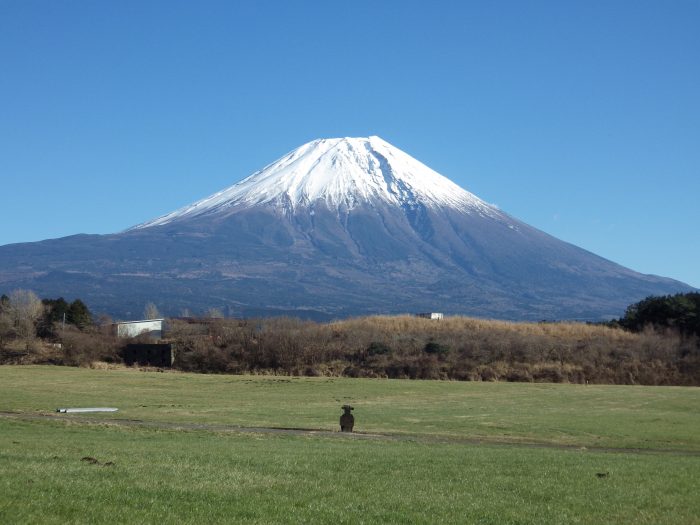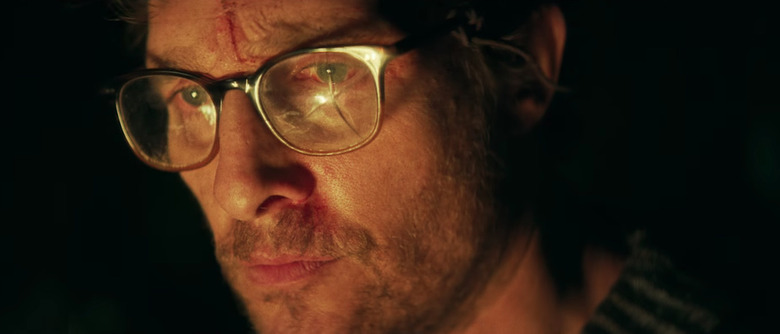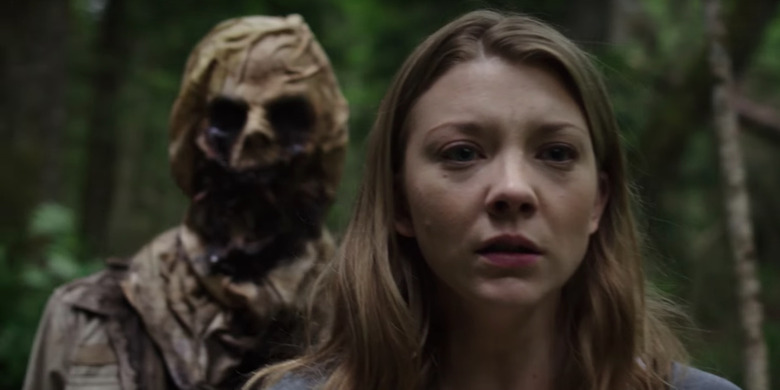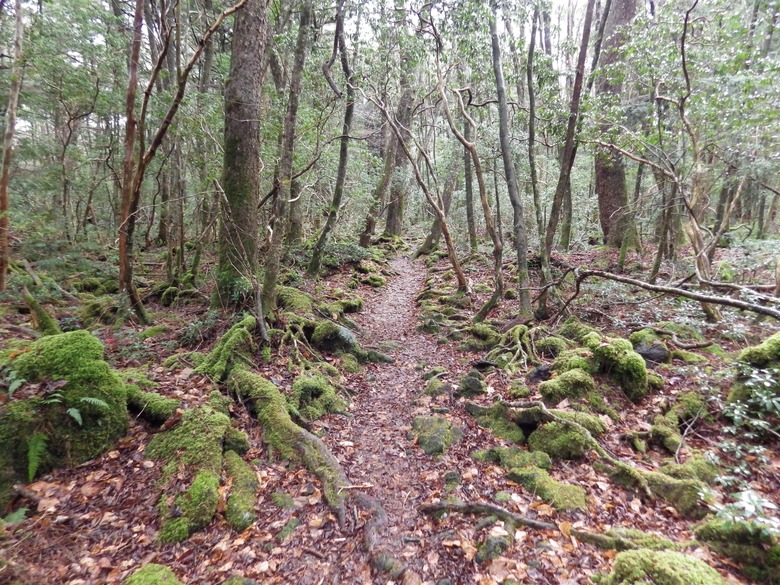Hollywood Was Getting "The Sea Of Trees" Wrong Long Before Logan Paul Ever Entered The Forest
As an American who lives in Japan and has spent time hiking the Jukai Nature Trail — which winds through Aokigahara, the so-called "suicide forest" — it hit close to home for me to see the Logan Paul controversy play out in the news. If you somehow missed it, Paul is the YouTube personality with over 16.5 million subscribers who shared a video of his Scooby-Doo-like crew stumbling across a corpse in the forest. He has since apologized, pledged to donate a million dollars to suicide prevention, and made his vlogging return.
Yet Paul's moment in the international spotlight hardly constitutes the first instance of Western media co-opting that sensational idea of a "suicide forest" as both clickbait and the initial hook for a foreigner's navel-gazing adventures on-screen.
Most recently, the 2016 film The Forest, starring Natalie Dormer of Game of Thrones fame, commandeered this legend for its own shlock-horror purposes. The legend is not without some basis in reality, mind you, but when Matthew McConaughey's character in the 2015 film The Sea of Trees Googles the phrase "a perfect place to die" and lands on an Aokigahara web page, there's a sense that this story and others like it are disseminating harmful notions, contributing to a historical tale that is possibly more a case of life imitating art than art imitating life.
The Sea of Trees
What was arguably most disturbing about Logan Paul's now-deleted forest video was the transgressive nature of the vlogger's actions, how he seemed to demonstrate supremely self-centered, almost sociopathic behavior while filming in the presence of a deceased person. In a way, the overarching narrative of Paul's soul-searching exile and comeback mirrors the journey of self-discovery that Matthew McConaughey's character undergoes in The Sea of Trees.
Gus Van Sant's 2015 film isn't as terrible as its 11% Tomatometer rating would suggest, but it's a weepy melodrama that telegraphs its twists, then ends with vapid smiles over the lessons learned from a Japanese man who is basically the Asian version of the Magical Negro. Ken Watanabe plays that character; McConaughey is Arthur Brennan, the depressed foreigner who hops on a plane to Japan without booking a return flight. He takes a taxi to the titular Sea of Trees, where he moves past a single abandoned car on the roadside before walking into the forest.
In reality, the trailhead is accessible via a parking lot on the same sightseeing bus loop as a bunch of other tourist attractions near Mount Fuji. To have Arthur ride the bus with tourists and encounter other hikers on the trail would clearly detract from Van Sant's romanticized vision of the forest as the "perfect place to die." It's a vision that others have shared, sadly, insofar as the same exact phrase was used to describe the Sea of Trees in a 1993 Japanese book called The Complete Manual of Suicide.
Copies of this book have reportedly been found on people's bodies inside the forest. This is how life imitates art. People first hear about the forest as a good place to go for seeing or doing bad things. Then they go there and more stories get written about how bad things have happened in the forest. It's a chicken-and-egg scenario. Which came first: the deaths or the folklore?
In an effort to overcompensate for its own dramatic inertia, perhaps, The Sea of Trees shows us a forest littered with human remains. Arthur encounters two recently deceased corpses, two skeletons, and two flowers that have sprouted up in the spot where people died (because that's the kind of Hallmark suicide movie this is). Yet the signature moss and crawling, above-ground roots that mark so much of the real Sea of Trees are nowhere to be found.
It's plainly a different forest: the terrain looks entirely dissimilar. What often gets overlooked about the Sea of Trees is the fact that the trees there grow on a bed of hardened lava from Mount Fuji, leaving their roots scrabbling for water in an unearthly volcanic landscape. There's really no place like it, which is maybe part of the reason why Hollywood films shot in the forests of Massachusetts and Serbia seem incapable of doing it justice.
In the end, the forest and Watanabe's character wind up being incidental to the movie's plot. What The Sea of Trees is really about is how Arthur learns to laugh again. This uplifting moral just so happens to be wrapped up in what Salon called "the worst movie ending of all time."
The Forest
The Forest is a film that producer David S. Goyer conceived after reading a Wikipedia entry about the Sea of Trees.
Let that sink in for a moment, because it sounds like that was the extent of Goyer's research. In an interview with Shockya, he said he had never heard of the forest before. After he "went down the rabbit hole" in that Wikipedia entry, however, he promptly drew up an outline for the film, which he then handed off to other screenwriters.
At the start of The Forest, Natalie Dormer's character, Sara, receives a phone call telling her that her twin sister has disappeared into the dreaded Aokigahara. Packing her bags and sounding like she's the very last person on earth who got the memo, Sara makes the dopey proclamation: "Apparently, they have a forest in Japan where people kill themselves." It's easy to imagine a similar light bulb going off over Goyer's head as he hatched the idea for this movie.
To his credit, first-time feature filmmaker Jason Zada appears to have gone a little farther than Goyer in researching the forest, insofar as he visited the actual place before pre-production on the film commenced. Ultimately, he and the production would only spend four days shooting in Japan – just enough time to tick off a small checklist of cliches and regurgitate a bit of Lost in Translation.
There's a driving sequence at the beginning of The Forest that plays out like a shot-for-shot remake of a scene in that movie. Here Dormer is substituted for Bill Murray as the jet-lagged foreigner making a cab ride past the same neon-lit district in Tokyo that Hugh Jackman also cruised by in The Wolverine. Girls in Lolita fashion stand on the street corner and sushi twitches on the plate. This is Hollywood's Japan.
As Sara disembarks the fictional train line to "Aokigahara Station" (no such place exists in real life), it soon becomes clear that the vivid setting being conjured on-screen is not just a heightened version of reality, but rather a straight-up alternate reality. It's the kind of place where beefcake Westerners named Aiden can slide up on a bar stool in remote Japanese locales — fluent yet somehow bad at pronouncing the language, able to chime in and finish lines of poetry that Sara starts quoting.
Inside the forest, all sense of place is gradually lost as the movie essentially turns into a cinematic rendition of a Halloween Horror Nights maze at Universal Studios. Those can be frightening and fun to experience, less so when you are watching them at a remove in someone else's amateurish videos. So it goes with this movie.
In The Forest, suicide victims hang from trees, but at least the characters here have the decency to cut them down. Despite that, there's a lingering sense through it all that movies like this are part of a greater myth-making cycle that has skewed public perception using appropriated cultural symbols.
One character insists, "The forest draws out your fear," but actually, it's the other way around. Movies like this draw out people's fear of the forest. The inability to get a cell phone signal is a well-worn horror cliche, but both The Forest and The Sea of Trees perpetuate a myth that The New York Times already dispelled about compasses going haywire in the Sea of Trees.
The Untold Story
There is one passing reference in The Forest that does hint at a larger story outside of the "suicide forest" narrative. Meeting with the principal at the school where her sister worked, Sara hears about the myth of senicide (leaving the elderly to die) in the Sea of Trees.
"That's awful," she says. I don't understand, why would the school take a class trip there?"
"Mount Fuji is very beautiful and important to history," the principal replies. "Aokigahara is simply part of the mountain."
The eruption of Mount Fuji that formed the Sea of Trees over a millennium ago triggered an intense worship of the volcano. In modern Japan, the mountain still enjoys sacred status as an icon of nature whose symmetrical beauty inspires residents, travelers, photographers, and filmmakers.

People visit the Sea of Trees to be closer to Mount Fuji. And yes, some of them in death. Over the years, a community of loneliness has grown up inside the forest, and with Japan providing less social mobility than other nations, there are not so many places where the average person can escape his or her circumstances and start life over.
Movies like The Sea of Trees and The Forest are not interested in that. Projecting an ignorant facsimile of the forest through the eyes of clueless, self-involved protagonists, they divorce the Sea of Trees from its true cultural context, contributing to the climate where it can live in people's imagination as a kind of haunted house or misery porn attraction.
These movies exploit real human grief with little to no regard for the damage they might inflict. They might as well take out a travel advertisement saying, "Come visit the real-life suicide forest where adventurers, thrill-seekers, and YouTubers can go to have a 'me' experience."
The real Sea of Trees is a place that's centuries older than all of us. It will outlive us all by centuries more unless some idiot using it as their own personal playground starts a forest fire and burns it down first. Theoretically, storytellers should be free to use any setting they want, but when a place comes with such a great burden of history — the baggage of lives lost in the real world — it immediately ups the ante in terms of responsibility.
Hey, Hollywood...for the next movie, maybe dig a little deeper than Wikipedia?



